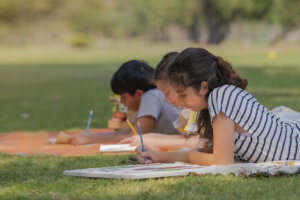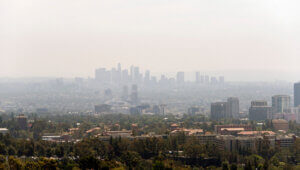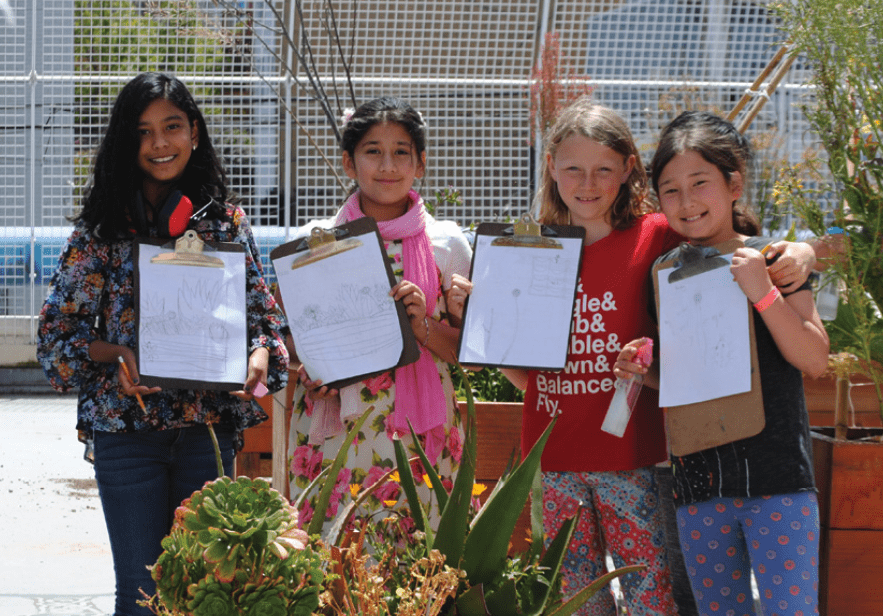Young people understand that the stakes in the battle against the climate crisis leave no room for excuses. In a world facing ongoing climate crises, youth bring a belief in science and the will to survive to counter powerful decision-makers driven by self-interest. Often dismissed by adults who believe they know better, the youth-led climate movement is fundamentally challenging the world to reckon with our impact on the planet. Students from San Mateo County are leading an initiative to rally their schools to pass a climate crisis declaration and follow it up with climate action plans.
Atiya Shah is a rising freshman at UC Berkeley who will be studying environmental economics and policy with plans to become an environmental lawyer. Maram Ahmed is a rising senior at Mills High School. After high school, Maram hopes to study civil or environmental engineering.
In this month’s interview, we spoke with two of the students leading the climate emergency declaration effort in San Mateo County.
How did you first get involved in the movement for climate justice, and what accomplishments have you seen result from your advocacy and leadership in San Mateo County?
Maram Ahmed: I first got involved in climate justice when I became a San Mateo County Youth Climate Ambassador. In that position, I worked with the Mills High School facilities and administration to install rain barrels at the school garden. That project was inspired by the fact that schools consume water at outrageous rates, despite the heavy rainfall during much of the year which has the potential to save gallons of water. However, the institutions built to serve youth often aren’t designed to hear students. The lack of clear communication led to the project dying down which highlighted the frustration that young people share in these situations.
Through our frustration and struggles to implement projects, Lilian, Atiya, and I met and we came to form the District Sustainability Committee in collaboration with the San Mateo Union High School District superintendent, teachers, and other students. The committee was created to advocate for and amplify student voices directly to the decision-makers. When we began, momentum was slow but we eventually got the district to hire site sustainability facilitators, which would be a point person who students could go to when wanting to implement projects. That was monumental because the lack of a sustainability leader is what caused a lot of projects to die down.
After this happened, the district also conducted baseline assessments of each high school and identified strengths and weaknesses in their environmental impact. From these resources that we fought to create, we were able to get our district to unanimously pass a declaration of climate emergency, which was spectacular because it opens the door to so many opportunities to drive sustainability within our district. Thus, we are developing a climate action plan in which the district actually addresses the declaration and commits to following through.
Our success inspired the Sequoia Union High School District to follow suit and they passed their own declaration of climate emergency in less than a month. Now we are working with the third high school district in the county to do the same. This goes to show that grassroots organizing and youth leadership can make a difference.
Atiya Shah: When I got involved with the San Mateo County Commission, I participated for three years. The first year, I was on the Immigrant Youth Committee but this past year I was the chair of the Environmental Justice Committee. One of our big projects was working to get all three high school districts in the county to pass the climate emergency declaration. The declaration is comprehensive because it includes a climate action plan that addresses campus biodiversity, energy waste, watersheds, environmental literacy, etc.
After a few months of reaching out to people, the San Mateo Union High School District Sustainability Committee was formed. The committee gave us a platform to be taken seriously by adults. At the same time, the Sequoia Union High School District was working on their climate declaration resolution, but they didn’t have a district sustainability committee and experienced trouble trying to get adults to take them seriously. District sustainability committees are the best way to bridge the adult and youth voices in relation to education and environment.
What distinguishes the role that youth play in the movement for climate justice?
Atiya: Youth have the most relevant, urgent voices because we ARE the future. If youth are more aware of their responsibility to the environment, then future generations will also see sustainability as a norm rather than something extra. Young people are especially adaptable and, as a result, we have so much innovation going on right now and we have the power to integrate sustainability into our lives from a very young age. We also have the power of social media on our side which can be both a good and a bad thing. When used productively, social media can amplify our voices.
Maram: Youth play a different role than older generations because we are charged with a different kind of fuel stemming from the fact that we are the heirs of the world. We will face the worst effects of climate change if action isn’t taken so we are not going to be quiet about it. Our generation grew up with the internet and social media, which has made us hyper aware of the social and environmental injustices facing marginalized communities. Talking about climate change is becoming more of a norm.
We are seeing youth join forces with like-minded people to demand action on a more united front. We have seen, through our experience, that united fronts are most effective in driving change. And the louder the voices are, the more that people are behind a movement, the more monumental its change will be.
How do you see the relationship between environmental education and climate justice?
Maram: The two could not have a stronger relationship. Environmental education is all about raising awareness about climate change and its implications on us individually. Introducing climate justice into these conversations, whether it be at schools or elsewhere, will encourage people to recognize the diverse perspectives of different communities, as opposed to having this closed view as to how climate change will affect them personally. Introducing these conversations will increase awareness about marginalized groups who face the brunt of climate change. By bringing these topics into classrooms, environmental education plays a key role in illuminating these social and environmental injustices, which would empower students and grassroots organizations to stand for climate justice.
Atiya: The root of any problem is education because education underlies how we shape people to understand how to view the world. Starting from preschool, learning basic habits like how to be less wasteful and more conservative of your resources can be important in training future generations to be more conscientious.
Climate change is not just learning about greenhouse gases (which was the extent of climate education I’ve received in school), it’s about being aware of your relationship to the earth and everything around you. If you start integrating environmental education from a young age, you become a more responsible human being and have a more worldly perspective on life.
What are some actions that would help address climate change and climate justice and who are the key actors in taking those actions?
Atiya: I’m a big advocate for anything relating to education because the grassroots level is so important. It’s also important to move to renewable energy but that requires legal action but it must happen alongside individuals taking actions to create a better planet.
The main actors in creating a more sustainable environment are the local governments, because they can make efforts to educate adults and youth on the proper mechanisms to achieve climate justice and be more sustainable. There needs to be efforts made by each county and they need to create some sort of climate action plan, similar to what we did, and follow through with it. Being on the Youth Commission for the past three years, I know how complex local governments are. We need designated people to help oversee waste, energy usage and watersheds.
Maram: Education is the root of all issues. Making environmental literacy a graduation requirement would ensure that future generations have the awareness to go into the world and adopt more sustainable habits and practices. However, conscious efforts on the individual level to consume less, save energy, drive less, eat less beef, etc. are not enough without action taken on a larger scale through local, national, and even international policy. Having a formal commitment to sustainability is essential in effectively combating climate change as it keeps both citizens and decision makers accountable.
How do you hope the climate movement evolves over the next five years? What do you hope happens and what do you want to see changed?
Maram: In five years I will be 22, meaning that I’ll be almost done with college and will be looking to kickstart my career, hopefully in civil and environmental engineering. I hope that by then the movement has become more comprehensive in that it encompasses every aspect of our lives, whether it be the economy or national policy as opposed to just being led by a few individuals.
I hope that the severity of climate change is not taken lightly and that all individuals recognize their responsibility to become more sustainable. And so I really want to see a culture shift during these five years. On a more grassroots level, I hope to see local governments join forces with community members as well as sustainability committees set up in every county because they’re essential in driving change.
Atiya: I want people to view climate change as being something that affects everyone personally and not a political thing we are detached from. I want to see less resistance to the fact that we are in a crisis and more people coming together to figure out a solution instead.
I want to see a stronger emphasis placed on education in regards to climate change. We need to make big efforts for students to understand the urgency of this problem so that the youth can be an even bigger facet into addressing climate change. Everyone needs to be aware about our own lives and how we affect the Earth. There is a lot of performative activism and people retweet things but they really don’t understand the value of their own actions.
Maram: I also hope the pressure is taken off youth to be the main drivers of this environmental movement and to see adults take initiative as well. Currently, I feel like whether it’d be us in our school communities or Greta Thunberg, most of the environmental advocacy is driven by youth. Young people are experiencing substantial anxiety with regards to this issue because it’s a crisis that our generation is facing, yet it feels as though many are in denial. Currently, it feels like it is entirely on our shoulders to drive this moment and create change, which I hope will change over the next five years.









